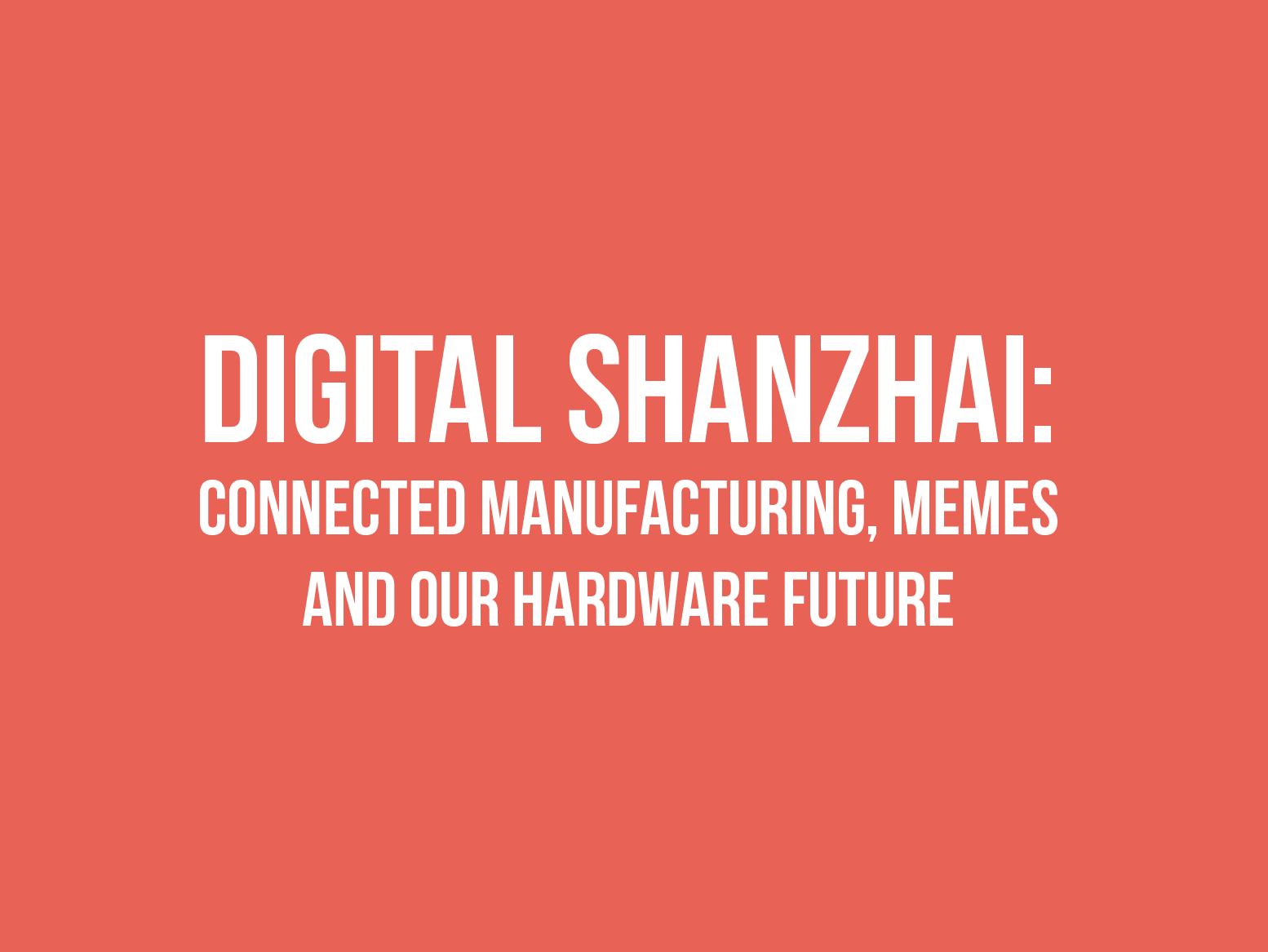By An Xiao Mina
An Xiao Mina is a technologist and researcher. She leads the product team at Meedan and is working on a book about internet memes and social movements. She is also a 2016-17 Berkman Klein Fellow.
I’ve become fascinated as of late by the manufacturing culture in Shenzhen and, having studied different aspects of Chinese internet meme culture, I was interested specifically in the role of the internet in the context of manufacturing. This interest is both academic and pragmatic—as a software product manager myself, I was also interested in what product teams more generally can learn from the work being done in Shenzhen. After some time in the Pearl River Delta and even more time reviewing literature and interviewing folks who’ve spent a much longer time looking at these questions, I got a better understanding of this.
“China is amidst a massive transition from a country primarily of manufacturers to one of makers,” I wrote in a recent essay for Fusion. “Internet platforms are speeding up production efficiency and enabling rapid, decentralized innovation through sharing and iteration. The implications of the internet meeting Shenzhen’s long-established environment for production point at substantial changes in what hardware can look like and who it can come from.”
Here are four more issues I’m interested in:
- In the new product lifecycle, feedback loops and production time are compressed substantially thanks to communications technologies. What this enables has yet to be fully explored.
In Shenzhen, I had a long conversation with Sam Hu, a project manager at Shenzhen Open Innovation Lab (SZOIL), a fablab and consultancy co-founded by DAH advisor David Li, who started China’s first hackerspace in Shanghai, and Guobin Yang, a maker affiliated with SZOIL. Hu and Yang were fonts of knowledge about the significant changes that digitization brought to production, something Hu called the new product lifecycle.
“The internet has shortened production time, from ideation to getting to market, substantially,” noted Sam. Hu oversees and advises a number of hardware innovation projects in the space, with a focus on those related to STEAM–Science, Technology, Engineering, Arts and Math. Ideation stands to benefit most. Traditionally, Hu explained, a medium sized company in China needed a product planning department to travel overseas, gather market info, collect ideas, and talk with the product branding team. Overall, the process could take 3-5 months for a basic mockup. Promotion required additional effort, such as traveling to trade shows in the US, Germany and the United States.
On a very good run, he said, the entire process from idea to market can now take as little as 2 weeks. This varies, of course, by product complexity, but the key point is around timeframes. All things being equal, V&A Gallery curator Luisa Mengioni pointed out in an interview, “in other countries, the same process would take at least three times longer.”Shenzhen sudu–Shenzhen speed–can be liberating. With such a short turnaround time, I’m interested in how this allows for iterative development of hardware, closer to the way we develop software, with short feedback cycles and experiments.
- Shanzhai culture in Shenzhen looks a lot to me like internet meme culture. This might be a more useful way to understand it, rather than simply bootleg or copycat culture.
Observing Shenzhen sparked a concept I started exploring at a recent talk at the Fabrication and HCI workshop SIGCHI: when internet culture meets production culture in Shenzhen, will products look fundamentally different than before? What does it mean when hardware is quick and easy to produce and disseminate, in batches large and small, by a wide variety of people? After looking at internet meme culture for so long, I started to see how shanzhai culture (“shanzhai” has traditionally been translated as “bootleg”) resembles what we might call hardware memes—hardware produced by decentralized networks of makers and manufacturers, with endless iterations of remixes and mashups.
Luisa Mengioni produced a fabulous series of videos, which I saw at the V&A Gallery’s installation at the Bi-City Biennale of Urbanism/Architecture in Shenzhen and is now on exhibition at the V&A in London, that looks at the wide range of production in the Pearl River Delta. Dubbed “Unidentified Acts of Design”, the series seeks to ask questions about the meaning of design in this context, outside of the traditional Western concept of the design studio.
“We’ve seen this story before,” I wrote in my essay for Fusion. Having looked at the internet’s impact on creative production of videos, images and artistic practice, I could see it extending to hardware, too. In the essay, I analogized the rise of creative hardware production to that of creative video production—with Shenzhen’s production culture lowering barriers to hardware experimentation in a way that is similar to what digital cameras and editing software have done for video. And the internet, by making these experiments visible to each other, can encourage a culture of remix and mashups in the same way video platforms like YouTube and Vine have–and in the case of hardware, those clicks and likes can lead to more sales..
Insightful in Mengioni’s video is the importance of gongban (circuit boards) and gongmo (cases for the boards). These available components facilitate rapid phone production cycles. “It’s basically like doing a recipe and having all the ingredients,” she noted in an interview with me. “So you can have endless variations around a simple concept.” David Li has also pointed out the importance of white label producers, and how others build off of those creations. As he reminded me, this means that what’s happening in Shenzhen isn’t magic: there’s a lot we can learn from this, especially those interested in building open hardware communities in their own local contexts.
- Shenzhen could become the Silicon Valley of hardware for a reason: it’s learning from and collaborating with Silicon Valley. The SV-SZ corridor is worth further exploration, as are our narratives around creative production.
HAX is an oft-cited example of an incubator from Silicon Valley setting up in Shenzhen to facilitate connections between makers and manufacturers. But there are many others. The central protagonist of my essay for Fusion, Lei Gao (also known as Gao Lei, who asked that I place his given name first, in Western style, for the article), works at a space called emielab, one of many hardware incubators in Shenzhen modeled after Silicon Valley incubator models. And many Chinese companies, like SEEED Studio, are setting up teams in California, to liaise with Western clients and explore business opportunities in the US. Hardware is so complex, and these Shenzhen-Silicon Valley collaborations have the potential to work by easing language and cultural barriers and helping hardware makers get access to consumers and manufacturers alike, on both sides of the Pacific.
Something about Silicon Valley that’s often misunderstood is the role of teams and collaboration. We often lionize the singular maker in the Valley, but the Valley gets its innovative strength from the networks it fosters through coworking spaces, incubators, meetup groups, mentorship programs and online networks that help with the cross pollination of ideas. In the Fusion piece, I used the story of Lei Gao (also known as Gao Lei, who asked that I place his given name first, in Western style, for the article) to illustrate the role of the internet in his process, but I didn’t have time to understand his full workflow. Hardware is notoriously difficult to produce, and in interviews with other makers, I’ve learned that makers and manufacturers are more like collaborators, with the push and pull that software design and development teams often have. I think telling more of these stories, and fleshing out the many collaborations along the way, can help us build a better understanding of where creativity comes from, and how we name it. It’s an exciting opportunity to move away from the idea of a single maker and instead look at collaborative making as a valid–and often more effective– form of creativity.
- Shipping networks are often overlooked, but they’re a key part of this story. How people move products from one end of the world to the other is part of Shenzhen’s advantage, but it’s hardly unique.
When a video goes viral on the internet, it can be viewed right away thanks to broadband internet. This hasn’t always been the case; anyone living in a low-bandwidth part of the world knows the pain of waiting hours to download a short video. When hardware goes viral on the internet, how does it end up in people’s hands? Except in the limited caseswhen a potential user might have access to a 3D printer, a physical product needs to travel by physical means, i.e., land, sea or air. If global broadband networks made it possible for all kinds of videos to spread quickly, global shipping networks are doing the same for hardware.
As with making and manufacturing, shipping and selling are seeing substantial changes thanks to the internet. In the Fusion piece, I look at the role of Taobao as a crowdfunding and sales platform, but we should also look more closely at the global implication s of this, including with global ecommerce platforms like Amazon, eBay and even Instagram. All those “Made in China” products have long needed big ships and established lines to reach every corner of the world in a matter of weeks. How independent sellers use online platforms Instagram, Amazon and other platform to capture images of the latest products from Shenzhen, show them to people back home, and test demand through clicks and likes is a question worth looking at more closely. If the demand is right, small sellers can send products on a ride on the same infrastructure that moves smartphones, hard drives, phone accessories, and all kinds of electronic devices from factories in Shenzhen to the hands of buyers thousands of miles away in Beijing, Shanghai, London, New York, Lagos and São Paulo.
You can read the full article, here.
Like hardware, the process of producing a story is deeply collaborative, with many people working behind the scenes to help inspire, iterate, test and perfect a narrative and the research behind it. In addition to the individuals cited in this article, the author would like to thank Samantha Culp, Guobin Yang, Leyi Li, Tim Hwang, Mary Ann O’Donnell, Ma Yongfeng, Dr. Jue Ren, Zara Arshad, Jiashan Wu, Lyn Jeffery, Zoe Ho, Jean Ryoo, Meg Escudé, Rachel Cassandra, Maira Sutton, Ilyse Iris Magy, the Bi-City Biennale of Urbanism/Architecture, and the SIGCHI 2016 Fabrication Workshop community.
This feature was written exclusively for Digital Asia Hub. To read more research and writing on the region visit our News section, here. For permission to republish or for interviews with the author please contact Dev Lewis.
- The Platform Futures conversations are now live! - June 12, 2021

